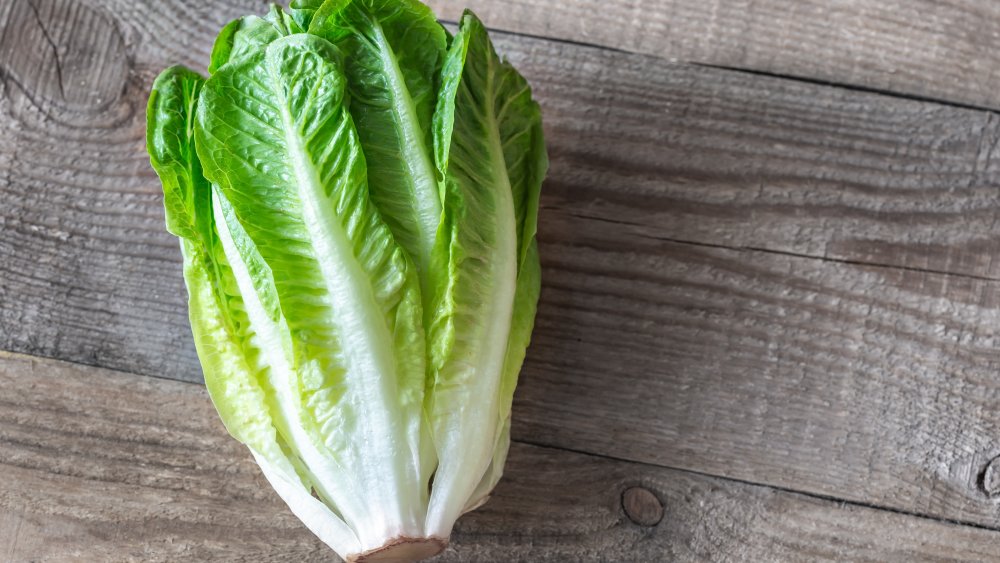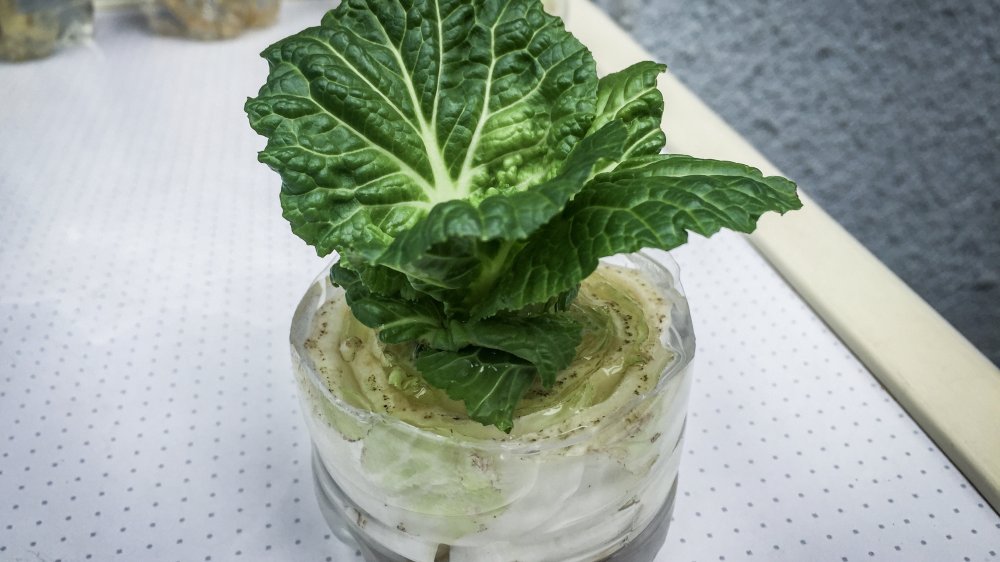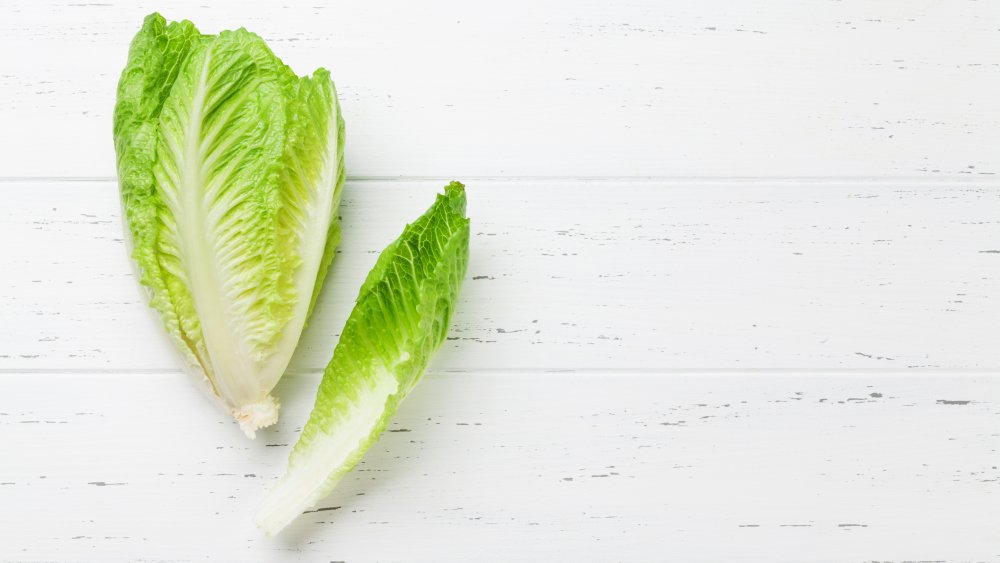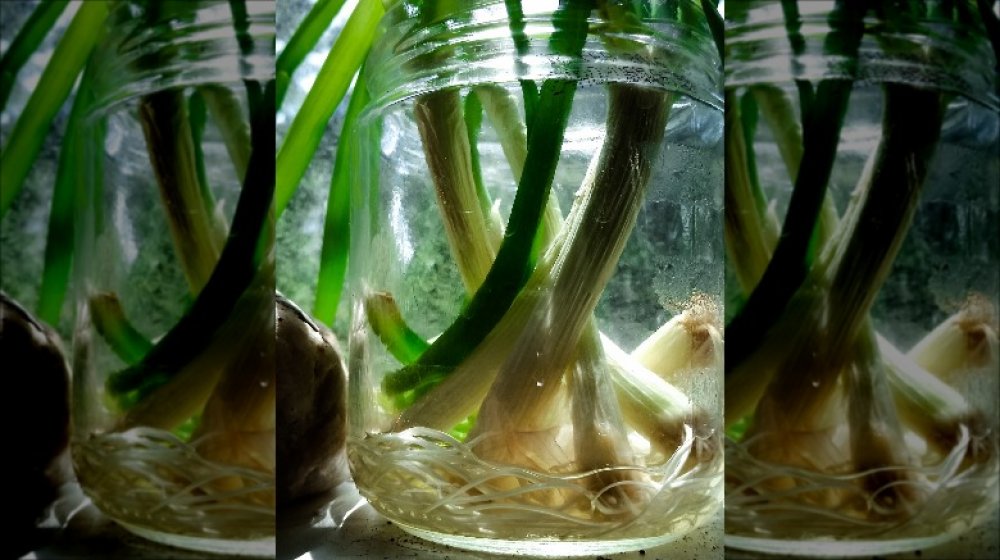Put A Romaine Heart In Water And Watch What Happens
Romaine lettuce is some pretty great stuff. Okay, so periodically it gets in a mood and tries to kill people via E. coli outbreak, but as long as you take the necessary precautions such as buying recall-free lettuce and sterilizing it with vinegar, romaine lettuce will make a nutritious addition to any meal. According to The Globe and Mail, romaine is the healthiest of all the different types of lettuce, delivering the most nutrients including beta carotene, folate, lutein, and potassium in every crunchy bite. Romaine's fresh green color also makes a pretty bed or side for any main dish, and it can even be used as a nice, sturdy wrap for a carb-free sandwich.
Did you know, though, that there's one more cute little trick that a head of romaine lettuce can perform? Actually, you won't even need the whole head, just the bottom part (or stem) of the romaine heart (via Lifehacker). Also, a glass of water. And a little (or a lot) of patience. Your reward, if all should go well? A little bitty mini-me regrown romaine.
How to regrow romaine from the heart
According to domestic goddess Getty Stewart (who is no relation to Martha, at least as far as we're aware), you just need to cut off the end of your romaine lettuce, leaving about one inch at the bottom. You can go ahead and eat the top part (check out these tips to keep your greens fresh and crisp). Then take that saved stem end and float it in a shallow dish of water — about half an inch is all you should need. Place your romaine-in-training on a sunny window sill or under a grow light, and then simply wait and watch. Don't forget to change out the water every day or two, though, otherwise it might start getting kind of icky and stinky. Your lettuce should start to grow pretty rapidly, with new shoots sprouting out the top end and maybe even a few roots appearing on the bottom.
What happens to your romaine heart then?
After 10 to 12 days, your romaine heart should have regrown a number of small leaves. This is as big as your lettuce is going to get, and if you leave it any longer, it's just going to start tasting bitter and nasty. If the leaves turn bluish or the leaves shoot up and turn spindly, you've left it in the water for too long.
Getty warns that this romaine lettuce trick isn't always going to work. She says she's tried it a dozen or so times, and in some instances, the romaine heart just wouldn't grow at all. Other times, it would quickly go to seed, and still other times it would grow for a few days, and then just seem to die.
Even when the lettuce does grow, it will not yield much more than can be used to make a very small salad. Unlike green onions, which can be entirely regrown over and over, romaine lettuce is not an infinitely renewable resource. It does, however, make for an interesting and edible science experiment, so why not give it a try? Come on, it'll be fun — and we mean this from the bottom of our (romaine) hearts.
What other produce scraps can be brought back to life?
While green onions may be the easiest veggies to regrow — simply cut them an inch above the roots and then place them in a glass of water — there are actually a number of different fruits and vegetables than can be at least partially regenerated from leftovers. Spud.CA instructs that bok choy and cabbage can be regrown using the same method as you use for romaine, and leeks regenerate in much the same way as do green onions (only much more slowly). If you place the top of a carrot in a shallow dish of water, you can regrow not the actual body of the carrot, but a steady supply of carrot tops, which turn out to be edible and even quite tasty in a soup, a saute, or a pesto.
Regrowing cilantro, basil, or mint requires starting them off in a glass of water, using at least 2 to 3 inches of stem, and then planting them in soil once they grow new roots. Soil will also be required for regrowing potatoes — plant a piece with the "eyes" looking up since these will turn into sprouts. It's even possible to regrow a pineapple by detaching the crown and getting it to sprout new roots in a glass of water, then repotting and then nurturing for at least a few years, although you may need a very warm climate or even a greenhouse if you really want to give Dole a run for their money.



